1997 CADILLAC SEVILLE fuel pressure
[x] Cancel search: fuel pressurePage 14 of 370
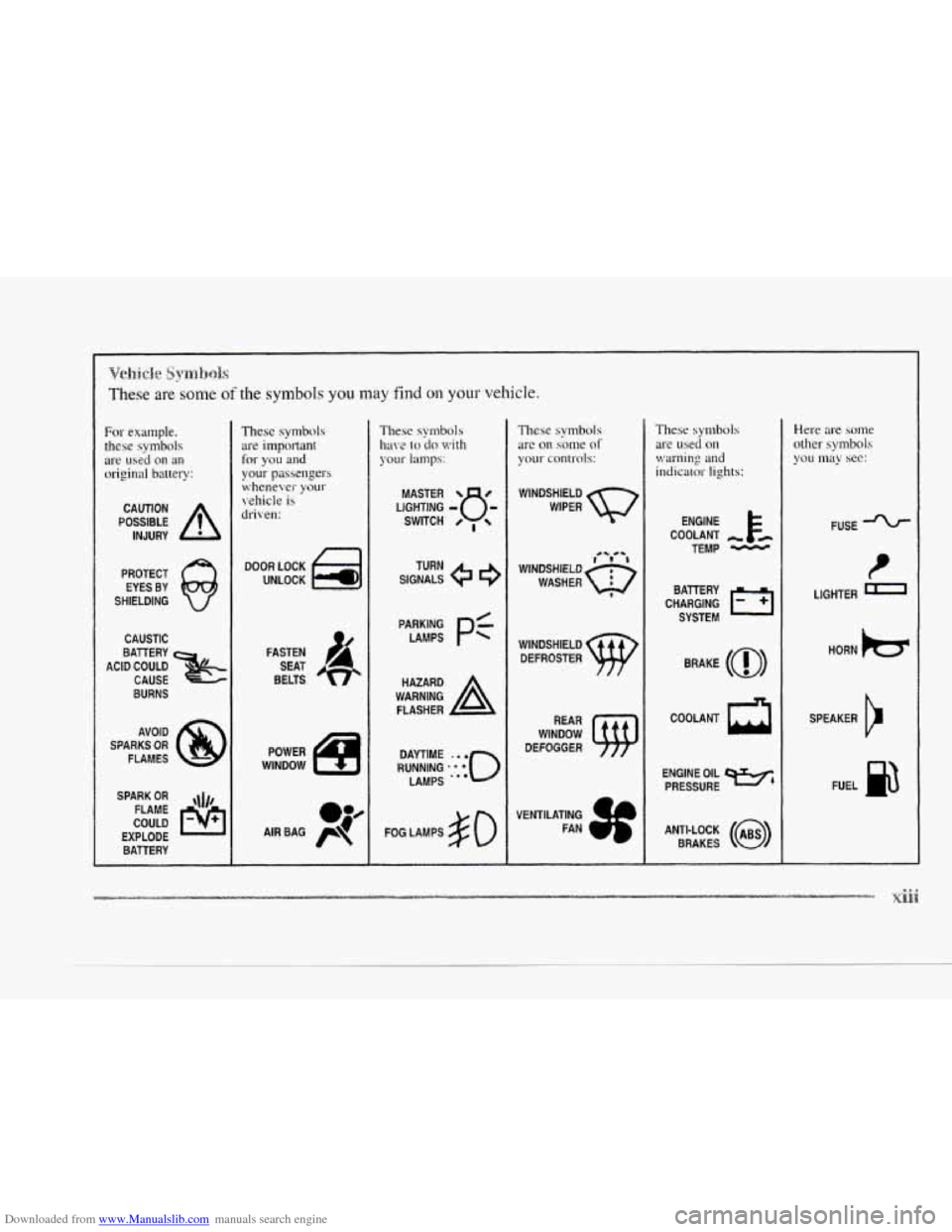
Downloaded from www.Manualslib.com manuals search engine c
c
c
c
c
VeSnicle Synb&
These are some of the symbols you may find 011 your vehicle.
For example.
these symbols
are used on
an
original battery:
POSSIBLE A
CAUTION
INJURY
PROTECT EYES
BY
SHIELDING
CAUSTIC
ACID COULD
x
BATTERY
CAUSE
BURNS
SPARK
OR ,\I/,
COULD FLAME
EXPLODE BATTERY
These symbols
arc
important
for you and
your passengers
u:henever your
\.chicle is
driven:
n
DOOR LOCK
UNLOCK
FASTEN BELTS SEAT
.;$-
e;/
AIR
BAG f!! FOG
LAMPS # 0
These symbols
are
on some of
your controls:
WINDSHIELD
WIPER
WINDSHIELD
DEFROSTER
VENTILATING FAN
These symbols
are used on
warning and
indicator lights:
COOLANT -
TEMP -
BRAKE (0)
COOLANT
a
ENGINE OIL w,
PRESSURE
ANTI-LOCK
(@)
BRAKES
Here are some
other symbols
you may see:
FUSE -%-
t
LIGHTER m
HORN kz7
SPEAKER
b
FUEL p3
Page 143 of 370
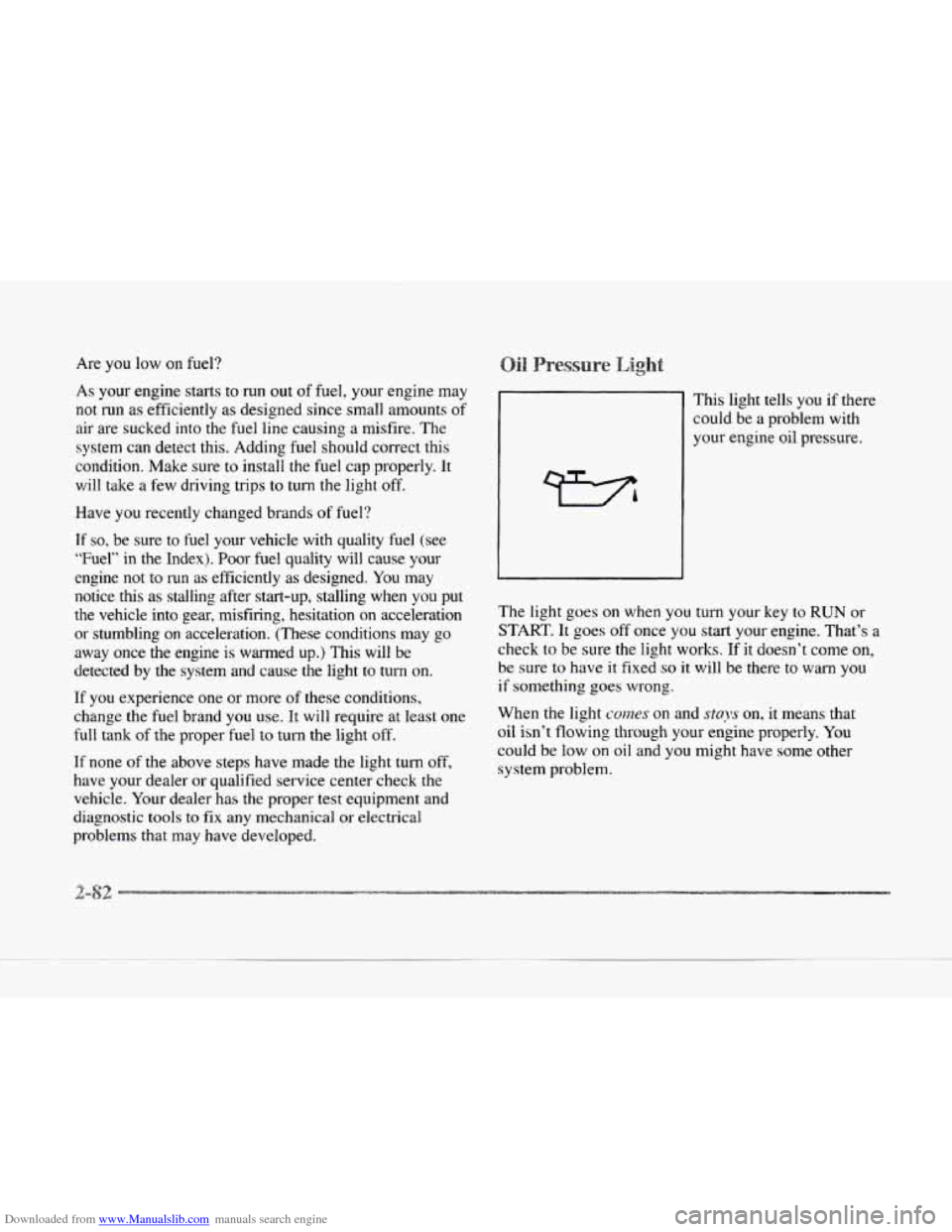
Downloaded from www.Manualslib.com manuals search engine Are you low on fuel?
As your engine starts to run
out of fuel, your engine may
not run as efficiently as designed since small amounts
of
air are sucked into the fuel line causing a misfire. The
system can detect this. Adding fuel should correct this
condition. Make sure to install the fuel
cap properly. It
will take a few driving trips to turn the light off.
Have
you recently changed brands of fuel?
If
so, be sure to fuel your vehicle with quality fuel (see
“Fuel”
in the Index). Poor fuel quality will cause your
engine not to run as efficiently as designed.
You may
notice this as stalling after start-up, stalling when you put
the vehicle into gear, misfiring, hesitation on acceleration
or stumbling on acceleration. (These conditions may go
away once the engine
is warmed up.) This will be
detected by the system and cause the light to
turn on.
If you experience one or more
of these conditions,
change the fuel brand
you use. It will require at least one
full tank of the proper fuel to turn the light off.
If none of the above steps have made the light turn
off,
have your dealer or qualified service center check the
vehicle. Your dealer has the proper
test equipment and
diagnostic tools
to fix any mechanical or electrical
problems that may have developed. This light
tells you if there
could be a problem with
your engine oil pressure.
The light
goes on when you turn your key to RUN or
START. It goes off once you start your engine. That‘s a
check
to be sure the light works. If it doesn’t come on,
be sure to have
it fixed so it will be there to warn you
if something goes wrong.
When
the light comes on and stays on, it means that
oil isn’t flowing through your engine properly.
You
could be low on oil and you might have some other
system problem.
Page 144 of 370
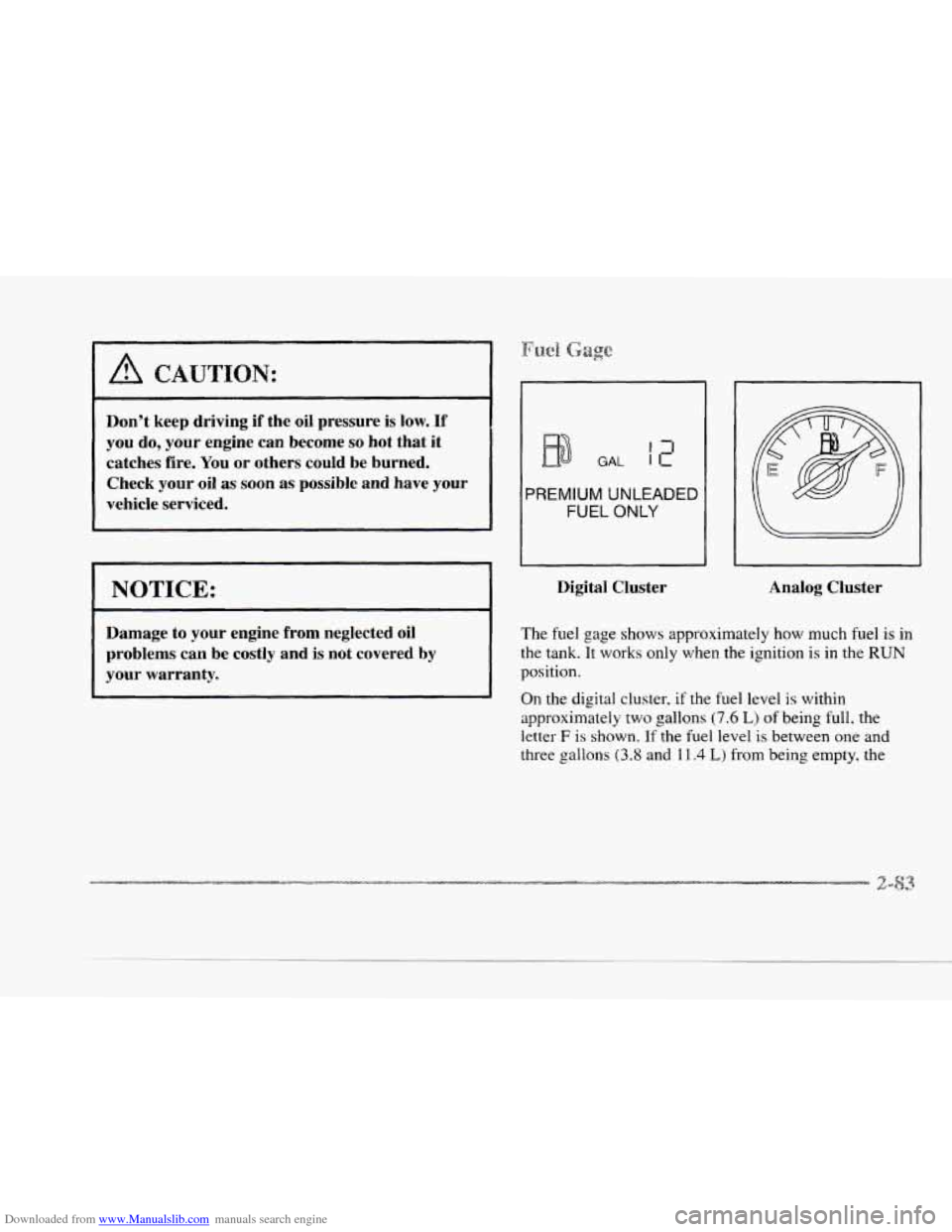
Downloaded from www.Manualslib.com manuals search engine c
c
c
A CAUTION:
Don't keep driving if the oil pressure is low. If
you do, your engine can become so hot that it
catches fire. You or others could be burned.
Check
your oii as soon as possible and have your
vehicle serviced.
NOTICE:
Damage to your engine from neglected oil
problems
can be costly and is not covered by
your warranty.
PREMIUM UNLEADED
FUEL ONLY
Digital Cluster
I
Analog Cluster
The fuel gage shows approximately how much fuel is in
the tank.
It works only when the ignition is in the RUN
position.
On the digital cluster, if the fuel level is within
approximately two gallons
(7.6 L) of being full, the
letter
F is shown. If the fuel level is between one and
three gallons
(3.S and 11.4 L) from being empty, the
Page 156 of 370

Downloaded from www.Manualslib.com manuals search engine c
c
STOP ENGINE LOW OIL PRESSURE - 35: If this
message appears while the engine is running, stop the
engine and do
!lot operate it until the cause of low oil
pressure
is corrected. Severe damage to the engine can
result.
A nlultiple chime will also sound when this
message is displayed.
THEFT SYSTEM YROBLEWCAR MAY NOT
RESTART
- 34: This message means there is a problem
in the Personalized Automotive Security System
(PASS-Key 11). A fault has been detected in the system
which means thzt the PASS-Key
I1 system is disabled
and is
not protecring the vehicle. The vehicle usually
restarts. however,
you may want to take your vehicle to
a proper service center before turning off the engine.
TOP SPEED FUEL CUT-OFF - 111: This message
will appear when the PCM senses that the maximum
speed
for your Cadillac has been reached. The speed
of your vehicle will decrease several mph as the fuel
supply is cutoff. This allows your vehicle
to stay in a
stable operating range.
TRACTION ENGAGED - 91: When your traction
control system is limiting wheel spin, the TRACTION
ENGAGED message will be displayed. Slippery road
conditions may exist if this message is displayed,
so
adjust your driving accordingly. This message. will stay
on
for a few seconds after the traction control system
stops limiting wheel spin.
TRACTION OFF - 89: This message will be displayed
after the traction control has been turned off.
TRACTION READY - 91: This message informs the
driver that the traction control system is available. This
occurs when
the traction doff button in the glove box
has been returned to an on position (pressing the button
once turns the traction control system
off pressing the
button again turns the system back on). This message
also self cancels after five seconds.
TRACTION SUSPENDED - 56: This message
displays when the traction control system has been
temporarily shut off because your vehicle’s brakes
have overheated. This message
does not indicate a
problem with your vehicle’s traction control system.
After a few minutes, the traction control system will
be available again and
the TRACTION READY
message will appear.
TRANS FLUID RESET - 48: With the engine not
running and the ignition on, press and hold the OFF
and rear defog buttons until the TRANS FLUID
RESET message appears
on the DIC (between five
and 20 seconds).
TRANSMISSION HOT .. 112: This messages indicates
that the transaxle fluid in your vehicle is too hot. Stop
and allow your vehicle to idle until it cools down or
until this message is removed.
Page 214 of 370
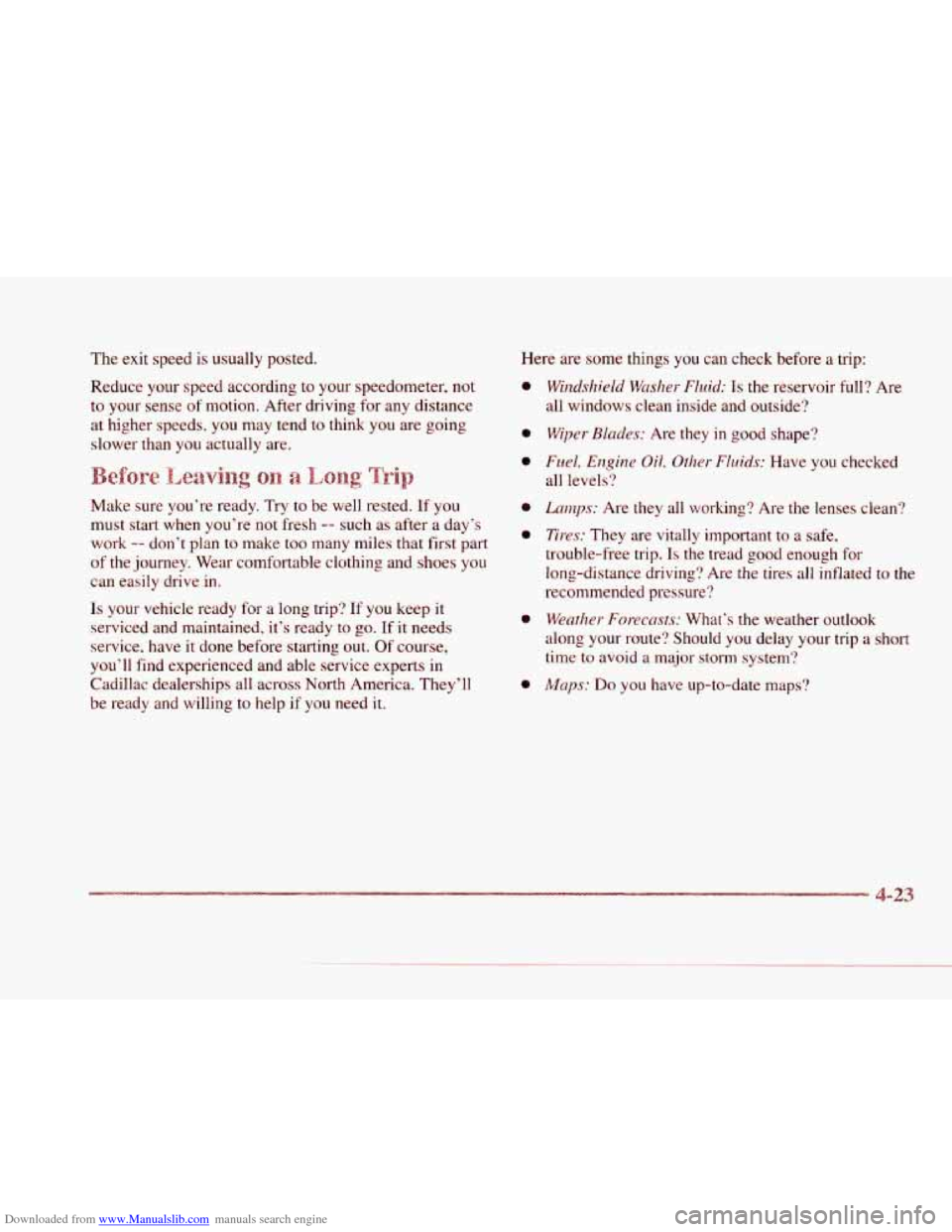
Downloaded from www.Manualslib.com manuals search engine c
II
c
L.
L-
P
The exit speed is usually posted.
Reduce your speed according to your speedometer, not
to your sense
of motion. After driving for any distance
at higher speeds, you may tend to think you are going
slower than you actually are.
Make sure you‘re ready. Try to
be well rested. If you
must
start when you’re not fresh -- such as after a day‘s
work
-- don’t plan to make too many miles that first part
of the journey. Wear comfortable clothing and shoes you
can easily drive in.
Is your vehicle ready for a long trip? If you keep it
serviced and maintained, it’s ready to
go. If it needs
service. have it done before starting out.
Of course,
you’ll find experienced and able service experts in
Cadillac dealerships all across North America. They’ll
be ready and willing to help if you need
it.
Here are some things you can check before a trip:
0
0
0
e
0
0
e
Wirzdshield Wcsher Fluid: Is the reservoir full? Are
all windows clean inside and outside?
Wiper- Blades: Are they in good shape?
Fuel, Engine Oil, Other Fluids: Have you checked
all levels?
Lcrmps: Are they all working? Are the lenses clean?
Tires: They are vitally important to a safe,
trouble-free trip.
Is the tread good enough for
long-distance driving? Are the tires all inflated to the
recommended pressure?
Weather Forecasts: What’s the weather outlook
along your route? Should
you delay your trip a short
time to avoid a major storm system?
hlcps: Do you have up-to-date maps?
-23
Page 221 of 370
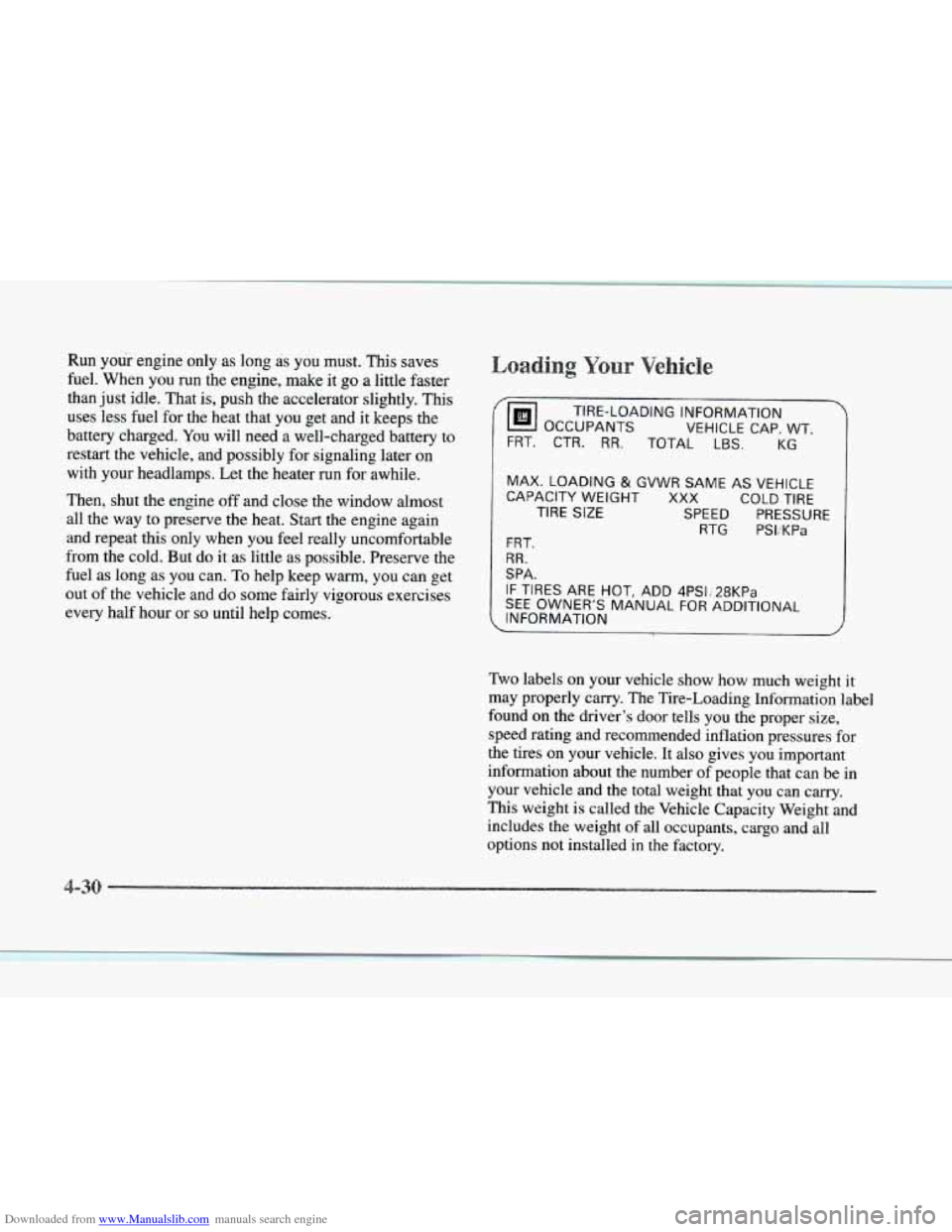
Downloaded from www.Manualslib.com manuals search engine Run your engine only as long as you must. This saves
fuel. When you
run the engine, make it go a little faster
than just idle. That is, push the accelerator slightly. This
uses less fuel ’for the heat that
you get and it keeps the
battery charged.
You will need a well-charged battery to
restart the vehicle, and possibly for signaling later on
with your headlamps. Let the heater
run for awhile.
-*- _--
Then, shut the engine off and close the window almost
all the way to preserve the heat. Start the engine again
and repeat this only when you feel really uncomfortable
from the cold. But do it as little as possible. Preserve the
fuel as long as you can.
To help keep warm, you can get
out of the vehicle and do some fairly vigorous exercises
every half hour or
so until help comes.
TIRE-LOADING INFORMATION
VEHICLE CAP. WT.
FRT.
CTR. RR. TOTAL LBS.
MAX. LOADING & GVWR SAME AS VEHICLE
CAPACITY WEIGHT
XXX COLD TIRE
TIRE SIZE SPEED PRESSURE
RTG
PSIiKPa
FRT.
RR.
SPA.
IF TIRES ARE HOT, ADD 4PSIi28KPa
SEE OWNER’S MANUAL FOR ADDITIONAL
INFORMATION
Two labels on your vehicle show how much weight it
may properly carry.
The Tire-Loading Information label
found on the driver’s door tells you the proper size,
speed rating and recommended inflation pressures for
the tires on your vehicle. It also gives you important
information about the number
of people that can be in
your vehicle and the total weight that you can carry.
This weight is called the Vehicle Capacity Weight and
includes the weight
of all occupants, cargo and all
options not installed in the factory.
I
-3
Page 309 of 370
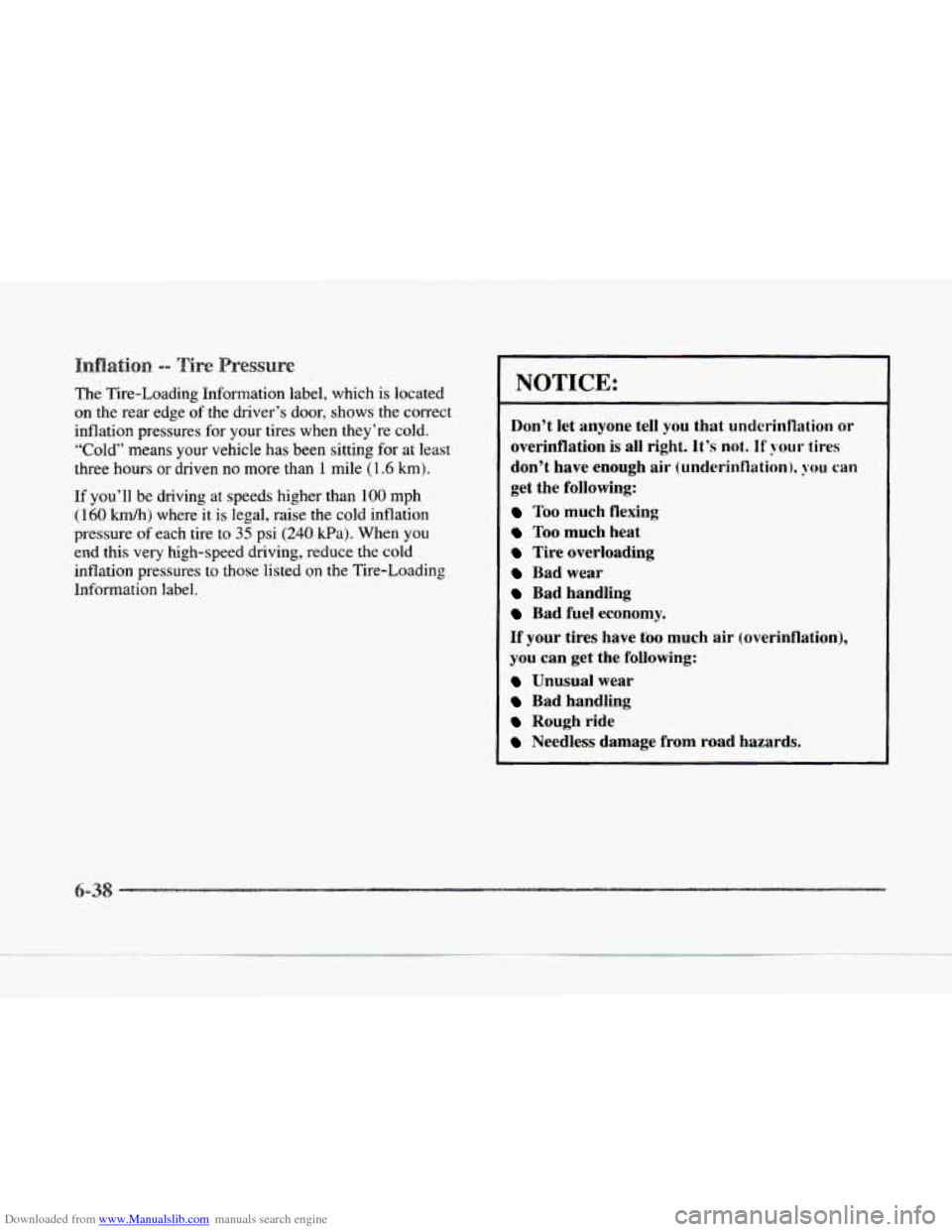
Downloaded from www.Manualslib.com manuals search engine The Tire-Loading Information label, which is located
on the rear edge of the driver’s door, shows the correct
inflation pressures for your tires when they’re
cold.
“Cold” means your vehicle has been sitting for at least
three hours or driven no more than
1 mile (1.6 km).
If you’ll
be driving at speeds higher than 100 mph
(160 Wh) where it is legal, raise the cold inflation
pressure of each tire
to 35 psi (240 Pa). When you
end this very high-speed driving, reduce the cold
inflation pressures
to those listed on the Tire-Loading
Information label.
NOTICE:
Don’t let anyone tell you that underinflation or
overinflation is all right.
it’s not. If‘ your tires
don’t have enough air (underinflation),
you can
get the following:
Too much flexing
Too much heat
Tire overloading
Bad wear
Bad handling
Bad fuel economy.
If your tires have too much air (overinflation),
you can get the following:
Unusual wear
Bad handling
Rough ride
Needless damage from road hazards.
1
Page 332 of 370
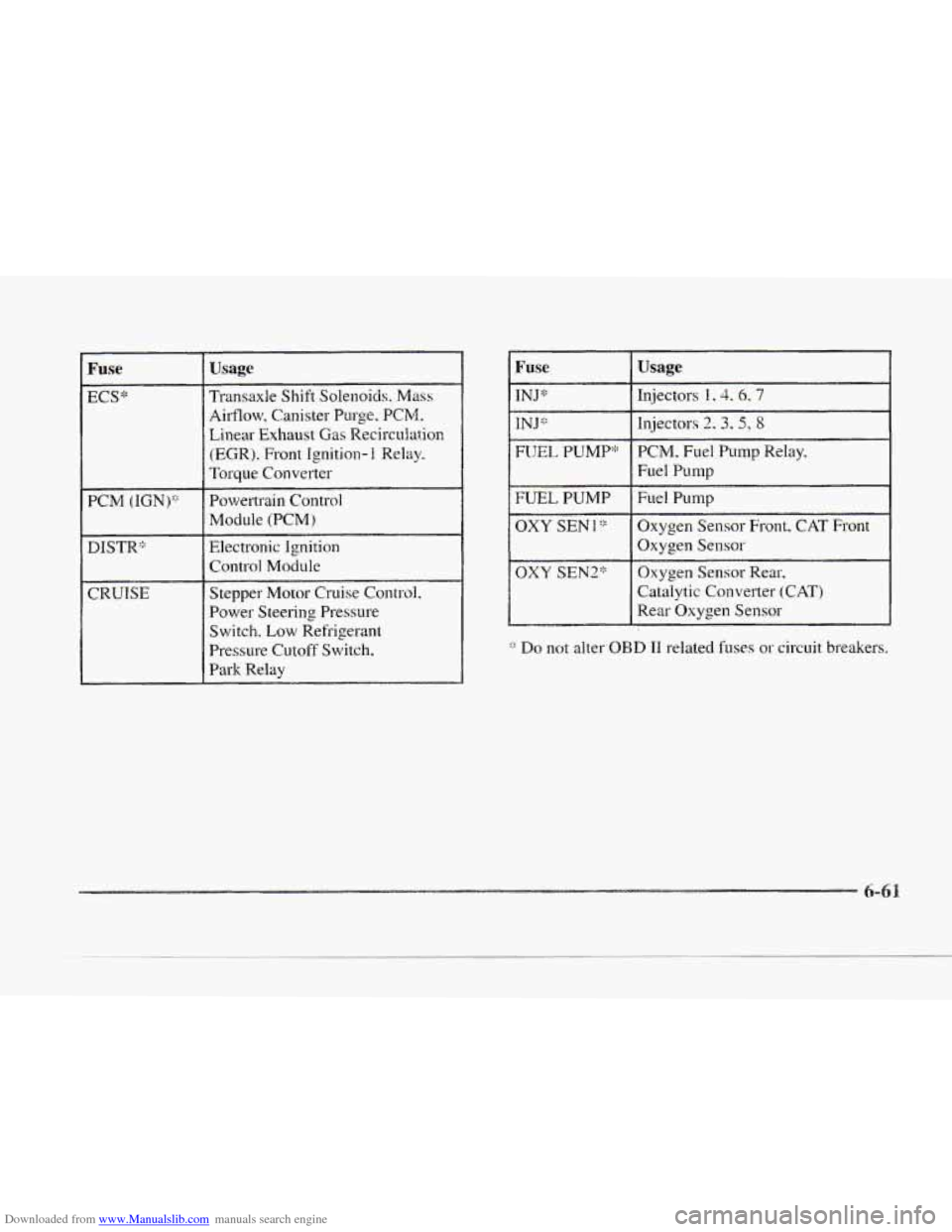
Downloaded from www.Manualslib.com manuals search engine LI.
c
c
1 DISTR'::
f CRUISE
I
Usage
Transaxle Shift Solenoids. Mass
Airflow, Canister Purge. PCM,
Linear Exhaust Gas Recirculation
(EGR). Front Ignition- 1 Relay.
Torque Converter
Powertrain Control
Module (PCM)
Electronic Ignition
Control Module
Stepper. Motor
Cruise Control,
Power Steering Pressure
Switch. Low Refrigerant
Pressure Cutoff Switch.
Park Relay
Fuse
FITEL PUMP"'
FUEL, PUMP
Usage
Injectors I. 46. 7
Injectors 2.3,5, 8
PCM. Fuel Pump Relay.
Fuel Pump -.
Fuel Pump
Oxygen Sensor Front, CAT Front
_-
Oxygen Sensor
Oxygen Sensor Rear.
Catalytic Converter (CAT)
Rear
Oxygen Sensor
::: Do not alter OBD I1 related fuses or circuit breakers.